SmartBoard 690
Greetings to% UserName%.
As early as four months I have the opportunity to use the “Smart board” SmartBoard 690. The characteristics of the board below:

The first thing that caught my eye was that she has a very decent weight due to the speakers that are attached on the sides. In appearance, we can say that they are small, but in fact they are completely metal, which is why the weight of the board is increased. In our case, the board was attached to metal beams that run vertically under drywall.
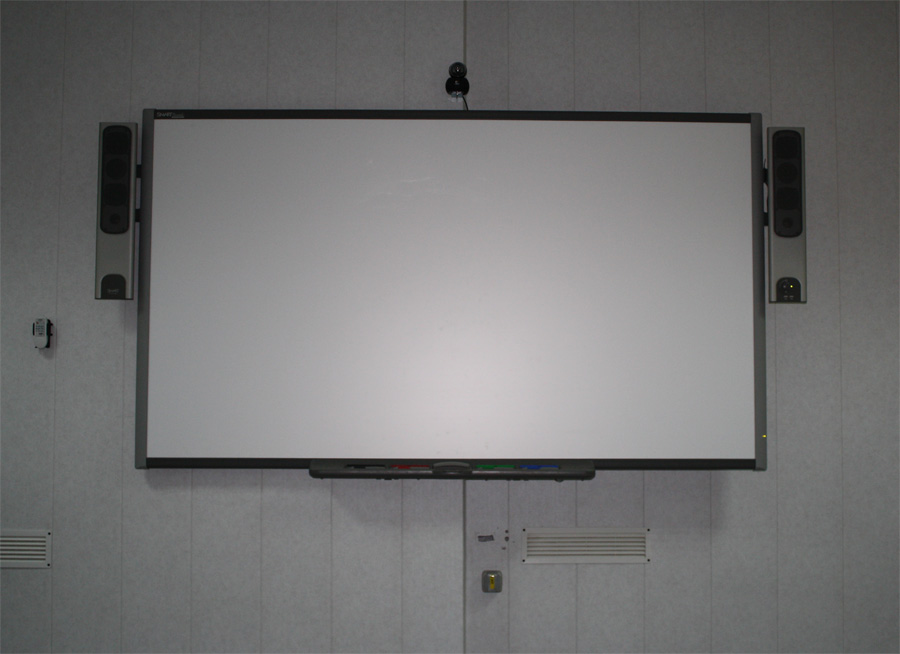

For speed and ease of use, multi-colored markers were made below, thanks to which you can immediately highlight the necessary moments in the presentation in different colors. Of course, this is also in the pen settings, but if there is not much time, then thesehotkey markers help a lot.
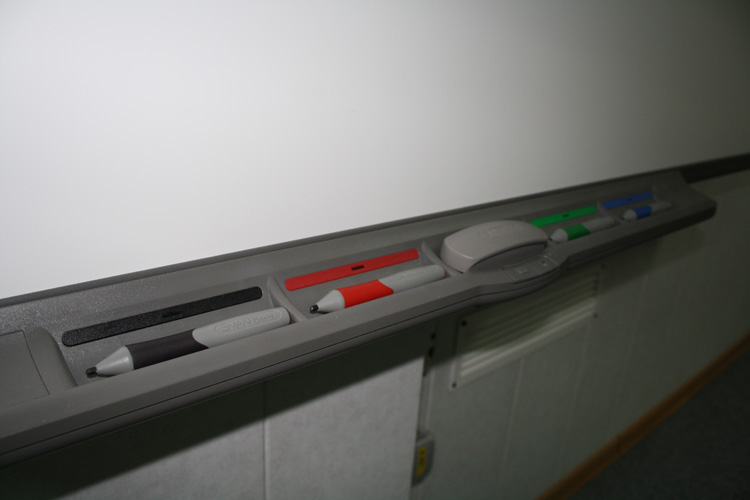
Like any board that interacts with a computer, it cannot work without the appropriate software. Any laptop that will connect to the board must have software from the supplied disk in its equipment. Without it, this board turns into ordinary speakers with a USB input for a USB flash drive (by the way, it’s also a very convenient thing, you don’t need to run to your laptop to throw off any files). Well, or if you want to watch a movie on the big screen.
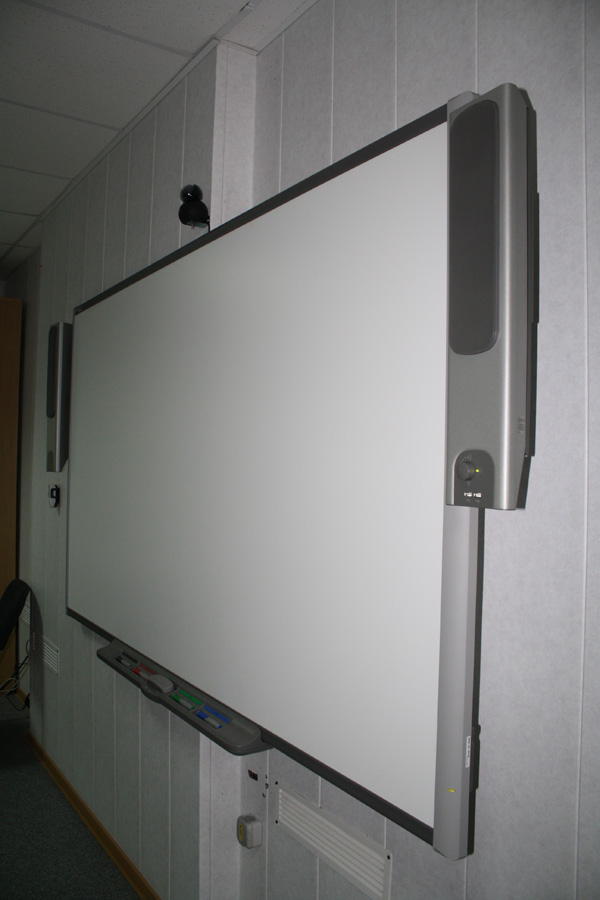
I liked the idea with highlighting for marker cells. As soon as you pick up the marker from the board, the lamp lights up below where it was lying and in dim light you can immediately see where to put the marker.
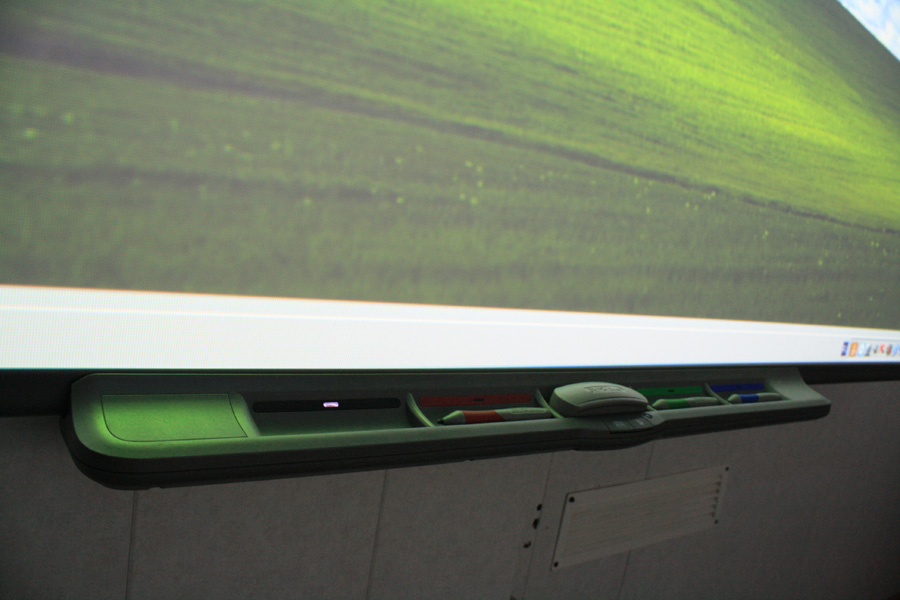
Basically, of course, the board software is sharpened for presentations. It is very convenient to use markers on each page of the presentation. There is an algorithm for remembering the changes made.
Software
package There is only one NoteBook program for working with presentations attached to the board, which is free; to activate it, you just need to send the serial number, which consists of two parts: the first is written on the board itself, the second on the disk that comes with it.
Of course, if you wish, you can buy additional software that allows you to expand the work of the board:
For example, we also purchased the SMART Bridgit program, which allows you to arrange video conferences between our regional offices. The program is integrated into those programs that are already installed and complements them with their functions. By and large, this allows you to broadcast your actions on the monitors of your interlocutors. They can also edit your data if such an opportunity is provided.
It was decided to install a webcam over the board so that you can conduct online conferences using Skype. The camera had to be able to rotate 180 degrees to cover the entire cabinet, so the choice fell on the camera - Logitech QuickCam® Sphere.
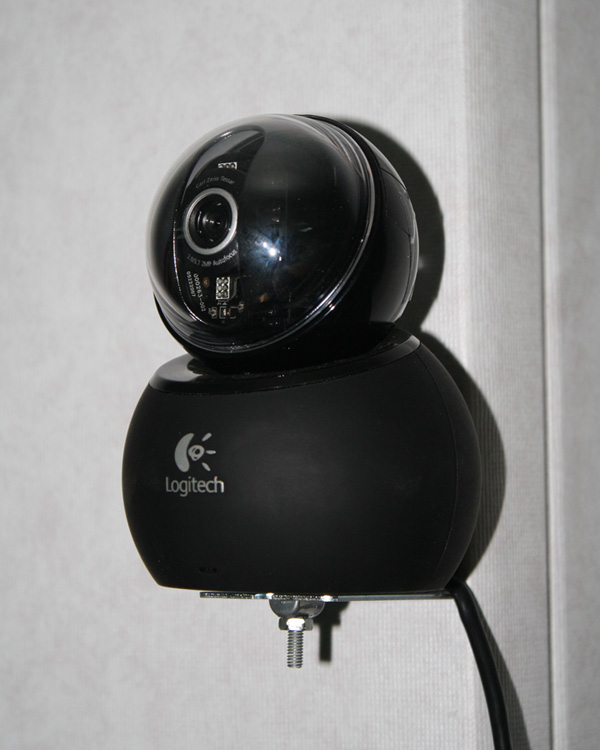
Since there is no mounting bracket for the camera on the board, it was attached 15cm above it, using a metal corner and two bolts. The camera is a desktop camera, therefore, attaching it with a bolt to the corner, I had to say goodbye to the guarantee.

Main features of Epson EB-410W (e):
A detailed press release here
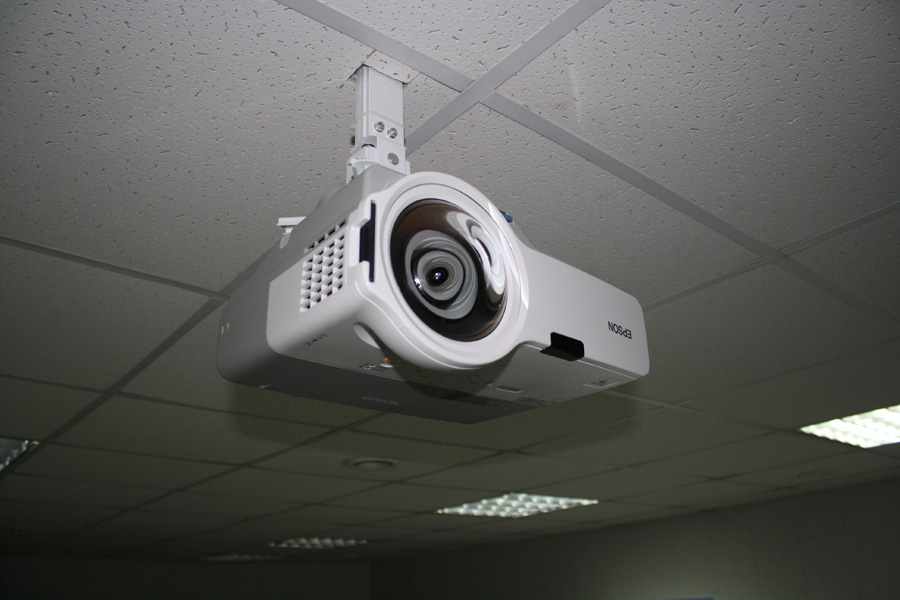

This projector is located a meter from the board, which practically does not give any shadow on the screen.
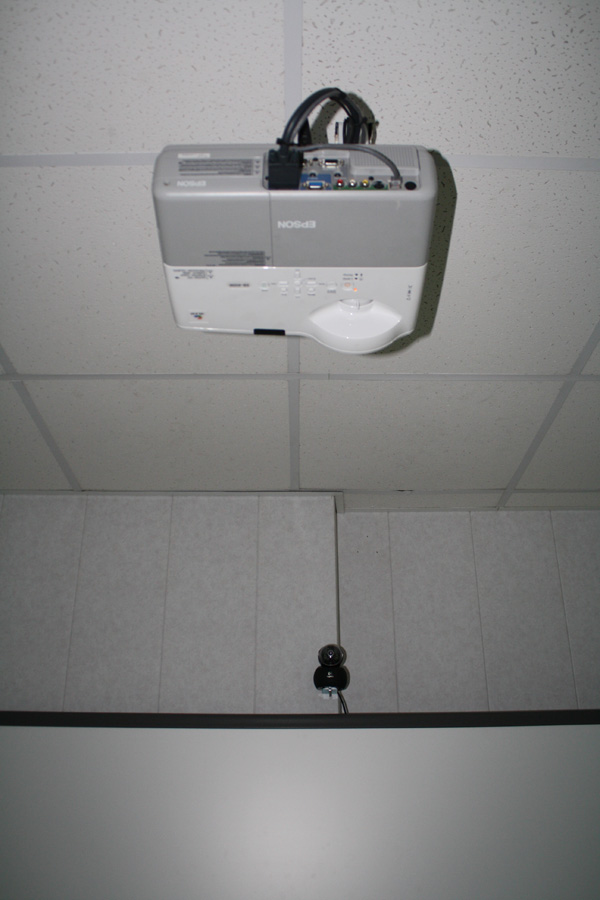
As with any whiteboard, glare comes from bright lamps and visibility is reduced, so any presentation comes with an extinguished "front" light and with the light on in the public area.
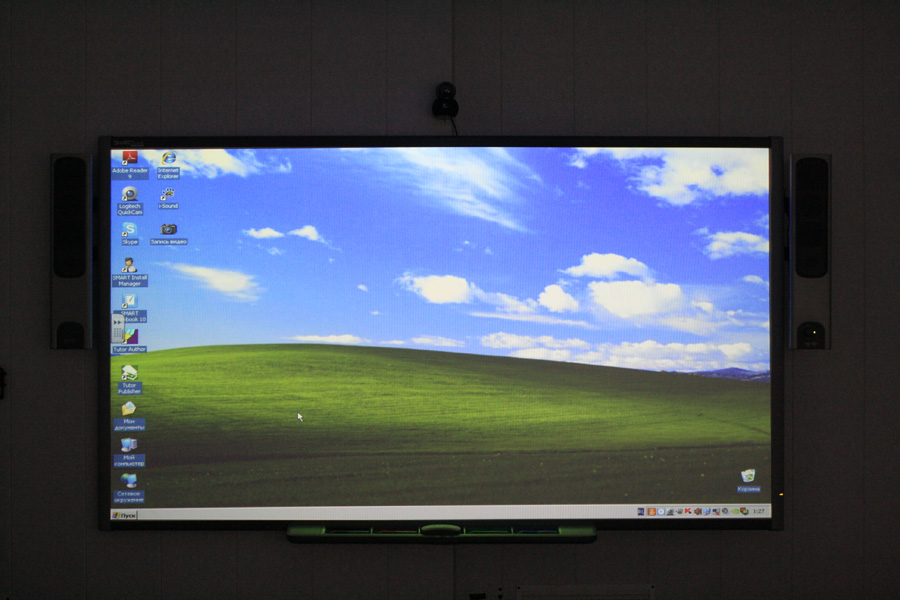
Updated software
At that moment, when the board arrived, a disk with the latest drivers came to it, in which there was no recognition of Russian handwritten letters.
The board has a chip - it can recognize handwritten Russian text, of course more or less readable. But when the board arrived, it recognized only English. letters, and instead of Russian there was an incomprehensible encoding. Despite the fact that some of the letters in the alphabets are simply the same: in the input mode English. the text worked, but it was worth switching to Russian - the letters were no longer recognized.
But the problem was quickly resolved when an updated version of the software was released.
Connection
diagram The connection diagram (included) of the board to the laptop is as follows:
A USB-B cord is inserted into the board, which goes with the USB end into the board, and the other into the adapter from which the RJ-45 comes out and then with the exact opposite order.
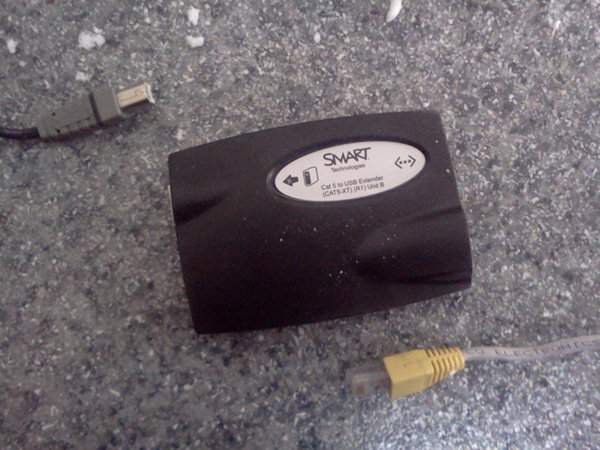
It turns out: {Board} - USB-B cable - {adapter} - patchcord - {adapter} - USB-B cable - {Notebook}
Therefore, if the cables are too long, the board had to disconnect if too many devices were connected to the laptop. With 3 of the 4 occupied USB ports (mouse, board, webcam), it was revealed that if you insert a USB flash drive into the remaining port, the board had to shut down. It’s not clear what this is connected with, but apparently with a lack of food.
A short video, if anyone is interested.
If someone noticed errors or shortcomings - write, correct.
It’s not very detailed, so if someone is interested in the details, ask questions in the comments, I will answer as far as possible.
As early as four months I have the opportunity to use the “Smart board” SmartBoard 690. The characteristics of the board below:

SMART Board 690
- Specifications:
- Type: direct projection board
- The size of the working surface: 1565x1172 mm
- Diagonal: 195 cm
- Principle of Operation: Resistive Technology
- Resolution: 4000x4000 px per touch
- Projector resolution support: 640x480: 1600x400 px
- Dimensions in working position: 165.7x125.7x13 cm
- Powered via USB 2.0 cable (supplied)
The first thing that caught my eye was that she has a very decent weight due to the speakers that are attached on the sides. In appearance, we can say that they are small, but in fact they are completely metal, which is why the weight of the board is increased. In our case, the board was attached to metal beams that run vertically under drywall.


For speed and ease of use, multi-colored markers were made below, thanks to which you can immediately highlight the necessary moments in the presentation in different colors. Of course, this is also in the pen settings, but if there is not much time, then these

Like any board that interacts with a computer, it cannot work without the appropriate software. Any laptop that will connect to the board must have software from the supplied disk in its equipment. Without it, this board turns into ordinary speakers with a USB input for a USB flash drive (by the way, it’s also a very convenient thing, you don’t need to run to your laptop to throw off any files). Well, or if you want to watch a movie on the big screen.

I liked the idea with highlighting for marker cells. As soon as you pick up the marker from the board, the lamp lights up below where it was lying and in dim light you can immediately see where to put the marker.

Basically, of course, the board software is sharpened for presentations. It is very convenient to use markers on each page of the presentation. There is an algorithm for remembering the changes made.
- If the user doesn’t work in a presentation program, such as PowerPoint, but simply on the desktop, then as soon as the user takes the marker, a “screenshot” is taken from the screen, which later draws, which makes it impossible to control the workstation. . To do this, put in place a marker to the slave. the table has become active;
- If the user picks up the marker when the presentation application is open on the screen, the window control remains and everything that is drawn on the screen “clings” to the sheet and remains on it when changing the sheet. Therefore, if you forgot to indicate something to the public and returned back to the previous sheet, everything that you painted earlier on it is loaded
Software
package There is only one NoteBook program for working with presentations attached to the board, which is free; to activate it, you just need to send the serial number, which consists of two parts: the first is written on the board itself, the second on the disk that comes with it.
Of course, if you wish, you can buy additional software that allows you to expand the work of the board:
- SMART Sync
- SMART Response CE
- SMART Notebook SE
- SMART Notebook MATH Tools
- SMART Ideas
- SMART Classroom Suite
- SMART Bridgit
- SMART Meeting Pro
For example, we also purchased the SMART Bridgit program, which allows you to arrange video conferences between our regional offices. The program is integrated into those programs that are already installed and complements them with their functions. By and large, this allows you to broadcast your actions on the monitors of your interlocutors. They can also edit your data if such an opportunity is provided.
Webcam
It was decided to install a webcam over the board so that you can conduct online conferences using Skype. The camera had to be able to rotate 180 degrees to cover the entire cabinet, so the choice fell on the camera - Logitech QuickCam® Sphere.

Since there is no mounting bracket for the camera on the board, it was attached 15cm above it, using a metal corner and two bolts. The camera is a desktop camera, therefore, attaching it with a bolt to the corner, I had to say goodbye to the guarantee.
Projector

Main features of Epson EB-410W (e):
- Ultra-short focal length: image from 53 ”(from a distance of 0.54 m) to 116” (from a distance of 1.22 m) (with WXGA resolution)
- 3LCD-panel with support for WXGA - resolution 1280x800dpi
- Powerful color stream: 2000 lumens
- Exclusive Epson E-TORL High Efficiency Lamp, (170 W UHE), Long Life: Up to 4,000 hours (Eco)
- Automatic keystone correction +/– 15 °
- Built-in speaker at 10 watts; perfect for small to medium sized rooms
- Noise Level: 28dB
A detailed press release here


This projector is located a meter from the board, which practically does not give any shadow on the screen.

As with any whiteboard, glare comes from bright lamps and visibility is reduced, so any presentation comes with an extinguished "front" light and with the light on in the public area.

Problems Difficulties
Updated software
At that moment, when the board arrived, a disk with the latest drivers came to it, in which there was no recognition of Russian handwritten letters.
The board has a chip - it can recognize handwritten Russian text, of course more or less readable. But when the board arrived, it recognized only English. letters, and instead of Russian there was an incomprehensible encoding. Despite the fact that some of the letters in the alphabets are simply the same: in the input mode English. the text worked, but it was worth switching to Russian - the letters were no longer recognized.
But the problem was quickly resolved when an updated version of the software was released.
Connection
diagram The connection diagram (included) of the board to the laptop is as follows:
A USB-B cord is inserted into the board, which goes with the USB end into the board, and the other into the adapter from which the RJ-45 comes out and then with the exact opposite order.

It turns out: {Board} - USB-B cable - {adapter} - patchcord - {adapter} - USB-B cable - {Notebook}
Therefore, if the cables are too long, the board had to disconnect if too many devices were connected to the laptop. With 3 of the 4 occupied USB ports (mouse, board, webcam), it was revealed that if you insert a USB flash drive into the remaining port, the board had to shut down. It’s not clear what this is connected with, but apparently with a lack of food.
Video
A short video, if anyone is interested.
If someone noticed errors or shortcomings - write, correct.
It’s not very detailed, so if someone is interested in the details, ask questions in the comments, I will answer as far as possible.
